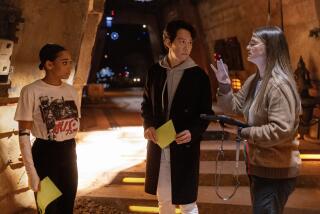Promoting Social Harmony With Positive TV Images
- Share via
When UCLA professor Halford Fairchild set out to create a television pilot program that would promote racial harmony, he learned that establishing equality in a TV production is just about as tough as accomplishing the same goal in real life.
Funded by a grant from the U.S. Department of Education, Fairchild’s “Star Crusaders” tells the story of a roving band of peacemakers made up of two black men, a Latino, a white man, an Asian woman and a robot. The Star Crusaders travel to the warring planet Umoja on a mission to restore harmony by utilizing non-violent weaponry, which includes acrobatics and logic.
Sculpting Values Fairchild, an assistant professor of social psychology and a faculty associate in UCLA’s Afro-American studies program, wanted to show how pro-social programming--as he calls television that presents models of cooperation and non-stereotypical roles--can sculpt the values and self-images of children.
He found, instead, he said, that the medium is often counterproductive to such goals.
In an article just released in the Journal of Educational Television, Fairchild, 35, recounts the production problems that hounded “Star Crusaders.”
Budget limitations, for instance, forced him to scrap the plan to portray warring factions on the alien planet. It was too costly to have the opposing groups differentiated by eye color, as the script originally called for. And union rules meant that in order to cast characters in equal-status relationships, as he had planned, he would have had to pay all the actors top scale.
Despite the setbacks, Fairchild said he remains convinced that television could help inspire harmony in society by showing examples of positive behavior. Studies have shown that the educational television series “Freestyle” and “Sesame Street,” as well as network series “The Waltons” and “Lassie,” have altered the attitudes of young viewers after repeated exposure, Fairchild said.
Yet a 1982 study cited by the professor showed that only 1% of children’s network programming depicted cross-racial associations. And those programs that have content favorably depicting social interaction tend not to be consistent in their messages, he said.
The child of a black father and a Japanese mother, Fairchild said he was the target of racial taunts himself growing up in a mostly black neighborhood of South-Central Los Angeles.
Subtle Messages Fairchild said he never connected the subtle messages conveyed by his favorite television shows with the oppression he experienced. “I loved Shirley Temple (in old movies on TV),” he said. “And I thought ‘Amos ‘n’ Andy’ was the greatest show on Earth.”
It wasn’t until later, when he began studying media in college, that Fairchild concluded that his favorite TV shows weren’t doing anything to improve his self-image.
In the late ‘60s, while Fairchild was working on a doctoral degree in social psychology at the University of Michigan, there appeared at local theaters a rash of what were then referred to as “blaxploitation” movies. Films such as “Cotton Comes to Harlem” and “Shaft” shared a theme Fairchild described as “a black superhero getting in his or her licks at white society.”
Black commentators objected to the trend, Fairchild remembered. Their argument was that seeing blacks portrayed as “pimps, dope fiends and vulgar individuals who violated the rules of society” was damaging to the self-esteem of black viewers.
But whenever Fairchild observed the audiences pouring out of the latest blaxploitation movie, he said he noticed that black viewers appeared to be elated, not demeaned.
Able to Identify It was Fairchild’s belief--borne out by later study of the literature on race relations--that it did people good to be able to identify with a black hero for a change, however questionable that hero’s life style.
In 1981, Fairchild was asked to consult on the writing of a proposal to the U.S. Department of Education for development of a pilot TV program intended to decrease prejudice and ease the isolation sometimes felt by minority groups.
The idea for Star Crusaders came to Fairchild one night while he was researching the proposal:
The year is 2081. Life on the planet Umoja (a Swahili word meaning unity) parallels life on Earth in the 1980s. Rampant racial and gender inequality has led to combat on the streets and among nations. Umoja even looks like Earth--the same cracked sidewalks, palm trees and office buildings. (This made it possible to film scenes set in Umoja in West Los Angeles neighborhoods, saving the cost of expensive sets.)
The Crusaders are approached by an influential citizen of Umoja. A middle-aged white woman, she asks the band to help restore peace to her planet where conflicting groups have escalated warfare to the point where annihilation of Umoja seems inevitable.
A lifelong science-fiction fan, Fairchild said he saw the concept of “Star Crusaders” as a cross between the popular television series “Star Trek” (a program that utilized some pro-social themes, Fairchild said) and “Mission: Impossible.” Each episode would see the Star Crusaders sent on yet another difficult mission, combating evil forces in the universe that promote hostility between groups.
Each of the Star Crusaders, as Fairchild envisioned it, would contribute equally to the resolution of the problems they tackled; and the solution would never be violent.
“Violence works on screen and is used so often in television because it is entertaining and visual,” Fairchild said. “But there are other ways to be entertaining and visual.”
Unfortunately, Fairchild was to find that the special effects needed to make a science-fiction plot entertaining were excessively expensive. (The total budget for the project was less than $100,000. Fairchild received a $75,000 grant from the U.S. Department of Education; the research component was funded by the National Science Foundation.)
Too Costly Because it was too costly to portray warring factions on Umoja, Fairchild had to settle for a sole “Hitlerian demagogue” whose aggressive policies headed the planet toward destruction. This plot change destroyed part of Fairchild’s original concept--that two opposing groups could be shown to learn to work together.
Fairchild’s vision was subverted in another case when, due to last-minute casting problems, three black extras were hired to portray a menacing group of street thugs. It had been Fairchild’s intent to avoid stereotypical images in the film, but the hoodlum scene shows blacks cast in negative stereotypes, complete with “head rags, toothpicks and mean demeanors,” as Fairchild put it.
The final tape--which differed considerably from Fairchild’s original concept--was shown to 104 UCLA undergraduates. Next, the pilot videotape was shown to 948 primary and secondary school children in five predominately black and Latino schools in the Los Angeles area. The groups were asked to report on how the program affected their attitudes and values in 18 areas, including competition, cooperation, individual achievement, group achievement and racial harmony.
Despite the fact that the pro-social themes had been compromised by budget and production considerations, Fairchild said that after seeing the film, “people tended to respond to other-race characters in a more favorable fashion.” The younger children, especially, reported positive identification with the Star Crusader leader, a black man named Jim.
Results among the older viewers were more ambiguous. But Fairchild said it would be unrealistic to expect one 30-minute program to alter ingrained attitudes.
Fairchild said his next move is to peddle Star Crusaders to production companies. With a larger budget and resources to aid in developing episodes, Fairchild is confident the show could be made to conform more closely to its intended purpose.
“Negative race and gender messages are being propagated by TV everyday. It’s just as easy to redirect these messages in a favorable light, without sacrificing audience appeal,” Fairchild said. “My dream is to see ‘Star Crusaders’ on television every Friday night.”
More to Read
The complete guide to home viewing
Get Screen Gab for everything about the TV shows and streaming movies everyone’s talking about.
You may occasionally receive promotional content from the Los Angeles Times.






